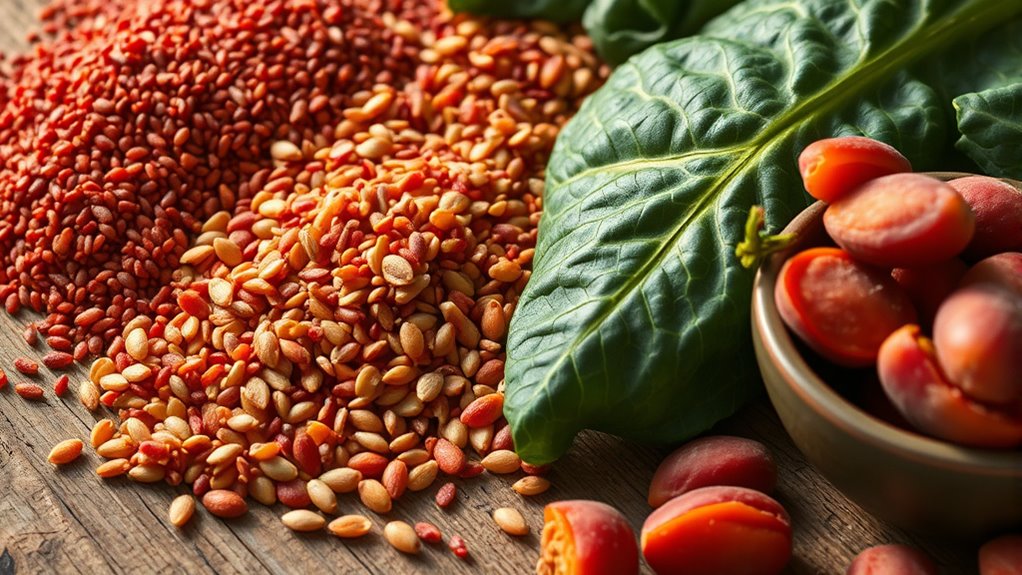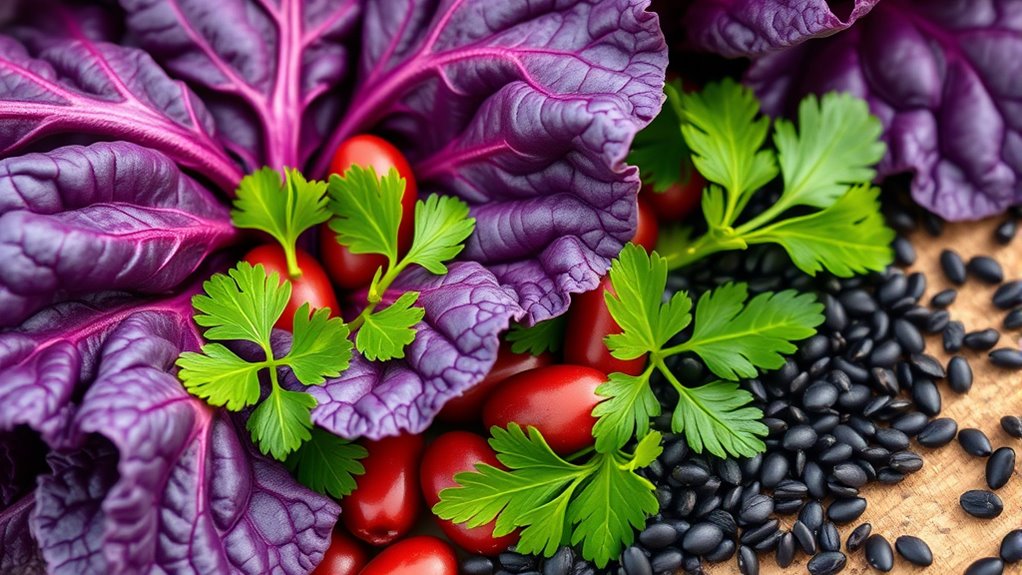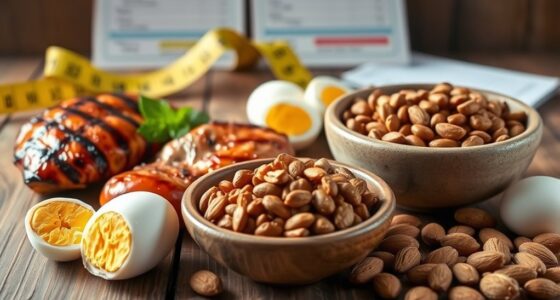If you want plant foods with higher bioavailable iron than spinach, try lentils, chickpeas, pumpkin seeds, or fortified cereals. Seeds like sesame and nuts such as cashews also pack a good iron punch. To boost absorption, include vitamin C-rich foods like citrus or peppers in your meals. Keep exploring further—there’s plenty of tasty and effective options to improve your iron intake beyond spinach.
Key Takeaways
- Legumes like lentils and chickpeas provide higher bioavailable iron than spinach.
- Seeds such as pumpkin and sesame are rich in iron with better absorption potential.
- Fortified cereals offer concentrated iron content, surpassing spinach’s levels.
- Nuts like cashews and almonds contribute iron, though in smaller amounts, complementing other sources.
- Combining plant iron sources with vitamin C-rich foods enhances absorption beyond spinach’s capabilities.

Are you looking to boost your iron intake with plant-based options? If so, you’re probably familiar with spinach, often touted as a top source of iron. But did you know there are other plant foods that can provide just as much, if not more, iron without some of spinach’s drawbacks? While spinach is a popular choice, it contains oxalates that can hinder iron absorption. Luckily, there are plenty of iron-rich plant foods that can help you meet your nutritional needs more efficiently. These include legumes, seeds, nuts, and certain vegetables, many of which are considered good sources of non-heme iron, the type found in plant foods.
One excellent way to maximize your iron intake is to incorporate heme iron sources, but since these are primarily from animal products, you’ll want to focus on plant-based iron sources that are rich in non-heme iron. To make sure your body actually absorbs this iron, pair your iron-rich foods with iron absorption enhancers. Vitamin C-rich foods like citrus fruits, bell peppers, and tomatoes can considerably improve non-heme iron absorption, making it easier for your body to utilize the iron you consume. For example, adding a squeeze of lemon to a chickpea salad or including bell peppers in a lentil stew can boost your iron levels more effectively.
Some plant foods stand out as superior iron sources, such as lentils, chickpeas, pumpkin seeds, sesame seeds, and fortified cereals. Lentils, in particular, are packed with iron and are easy to incorporate into your meals. When you prepare dishes with these foods, think about including vitamin C-rich ingredients to enhance absorption. For instance, adding tomatoes or citrus to your lentil soup can make a notable difference. Nuts like cashews and almonds also contribute small amounts of iron, and combining them with vitamin C-rich snacks can help your body absorb more of their mineral content.
Frequently Asked Questions
Can These Iron-Rich Plants Help With Iron Deficiency Anemia?
You might wonder if plant-based iron sources can help with iron deficiency anemia. The good news is, yes, they can support anemia prevention by providing essential non-heme iron. Including foods like lentils, tofu, and fortified cereals in your diet boosts your iron intake naturally. While they may not be as easily absorbed as animal products, combining them with vitamin C-rich foods can improve absorption and help you manage or prevent anemia effectively.
Are There Any Side Effects From Consuming These Plant Foods?
You might wonder if consuming these iron-rich plant foods causes side effects. While they’re generally safe, watch out for plant toxicity issues in certain varieties, and consider nutrient interactions, like calcium or tannins, which can hinder iron absorption. Eating a diverse diet helps minimize risks. If you experience symptoms like stomach upset or allergic reactions, consult a healthcare professional. Overall, these foods are beneficial when consumed mindfully.
How Do Cooking Methods Affect Iron Content in These Foods?
Cooking techniques critically impact nutrient retention in plant foods. For example, boiling can cause iron loss through leaching into water, while steaming helps preserve iron content. To maximize your iron intake, opt for cooking methods like roasting or sautéing, which retain more nutrients. Remember, gentle cooking preserves more iron, so avoid overcooking. Proper techniques ensure you get the most benefit from your plant-based iron sources.
Can Vegetarians Meet Their Iron Needs With These Plants Alone?
Ever wonder if you can meet your iron needs solely through plant foods? You can, but it requires planning. Vegetarians should include iron-rich plants like legumes, seeds, and fortified foods to boost intake. Relying on iron supplementation might be necessary if dietary sources aren’t enough, especially for those with higher needs. Combining vitamin C-rich foods with plant iron sources enhances absorption, making it easier to stay healthy without animal products.
Which of These Foods Are Best for Boosting Iron Absorption?
To boost your iron absorption from plant foods, focus on those with high plant iron bioavailability. Incorporate vitamin C-rich foods like bell peppers, citrus, or tomatoes alongside iron sources to enhance absorption through vitamin C synergy. Avoid tea or coffee during meals, as tannins can hinder iron uptake. Combining these strategies guarantees your body absorbs more iron, helping you meet your nutritional needs effectively.
Conclusion
Think of iron-rich plant foods as the hidden gems in your culinary treasure chest. By exploring options beyond spinach, you open a world of vibrant, nourishing options that fuel your body and brighten your day. Don’t let your diet be a dull map—let it be a colorful journey filled with surprises. Embrace these foods as your trusty compass, guiding you toward stronger health and vitality with every delicious bite.









